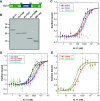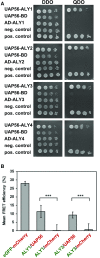ALY RNA-Binding Proteins Are Required for Nucleocytosolic mRNA Transport and Modulate Plant Growth and Development
- PMID: 29540591
- PMCID: PMC5933122
- DOI: 10.1104/pp.18.00173
ALY RNA-Binding Proteins Are Required for Nucleocytosolic mRNA Transport and Modulate Plant Growth and Development
Abstract
The regulated transport of mRNAs from the cell nucleus to the cytosol is a critical step linking transcript synthesis and processing with translation. However, in plants, only a few of the factors that act in the mRNA export pathway have been functionally characterized. Flowering plant genomes encode several members of the ALY protein family, which function as mRNA export factors in other organisms. Arabidopsis (Arabidopsis thaliana) ALY1 to ALY4 are commonly detected in root and leaf cells, but they are differentially expressed in reproductive tissue. Moreover, the subnuclear distribution of ALY1/2 differs from that of ALY3/4. ALY1 binds with higher affinity to single-stranded RNA than double-stranded RNA and single-stranded DNA and interacts preferentially with 5-methylcytosine-modified single-stranded RNA. Compared with the full-length protein, the individual RNA recognition motif of ALY1 binds RNA only weakly. ALY proteins interact with the RNA helicase UAP56, indicating a link to the mRNA export machinery. Consistently, ALY1 complements the lethal phenotype of yeast cells lacking the ALY1 ortholog Yra1. Whereas individual aly mutants have a wild-type appearance, disruption of ALY1 to ALY4 in 4xaly plants causes vegetative and reproductive defects, including strongly reduced growth, altered flower morphology, as well as abnormal ovules and female gametophytes, causing reduced seed production. Moreover, polyadenylated mRNAs accumulate in the nuclei of 4xaly cells. Our results highlight the requirement of efficient mRNA nucleocytosolic transport for proper plant growth and development and indicate that ALY1 to ALY4 act partly redundantly in this process; however, differences in expression and subnuclear localization suggest distinct functions.
© 2018 American Society of Plant Biologists. All Rights Reserved.
Figures








Similar articles
-
The UAP56-Interacting Export Factors UIEF1 and UIEF2 Function in mRNA Export.Plant Physiol. 2019 Apr;179(4):1525-1536. doi: 10.1104/pp.18.01476. Epub 2019 Jan 30. Plant Physiol. 2019. PMID: 30700540 Free PMC article.
-
Arabidopsis DEAD-box RNA helicase UAP56 interacts with both RNA and DNA as well as with mRNA export factors.PLoS One. 2013;8(3):e60644. doi: 10.1371/journal.pone.0060644. Epub 2013 Mar 26. PLoS One. 2013. PMID: 23555998 Free PMC article.
-
The RNA Export Factor ALY1 Enables Genome-Wide RNA-Directed DNA Methylation.Plant Cell. 2019 Apr;31(4):759-774. doi: 10.1105/tpc.18.00624. Epub 2019 Feb 27. Plant Cell. 2019. PMID: 30814259 Free PMC article.
-
Nuclear RNA export and its importance in abiotic stress responses of plants.Curr Top Microbiol Immunol. 2008;326:235-55. doi: 10.1007/978-3-540-76776-3_13. Curr Top Microbiol Immunol. 2008. PMID: 18630756 Review.
-
Regulated RNA processing in the control of Arabidopsis flowering.Int J Dev Biol. 2005;49(5-6):773-80. doi: 10.1387/ijdb.051995vq. Int J Dev Biol. 2005. PMID: 16096981 Review.
Cited by
-
Characterization of Local and Systemic Impact of Whitefly (Bemisia tabaci) Feeding and Whitefly-Transmitted Tomato Mottle Virus Infection on Tomato Leaves by Comprehensive Proteomics.Int J Mol Sci. 2020 Sep 30;21(19):7241. doi: 10.3390/ijms21197241. Int J Mol Sci. 2020. PMID: 33008056 Free PMC article.
-
Distinct role of subunits of the Arabidopsis RNA polymerase II elongation factor PAF1C in transcriptional reprogramming.Front Plant Sci. 2022 Sep 29;13:974625. doi: 10.3389/fpls.2022.974625. eCollection 2022. Front Plant Sci. 2022. PMID: 36247629 Free PMC article.
-
Nuclear export of plant pararetrovirus mRNAs involves the TREX complex, two viral proteins and the highly structured 5' leader region.Nucleic Acids Res. 2021 Sep 7;49(15):8900-8922. doi: 10.1093/nar/gkab653. Nucleic Acids Res. 2021. PMID: 34370034 Free PMC article.
-
Transcriptomic Analysis of Alternative Splicing Events during Different Fruit Ripening Stages of Coffea arabica L.Genes (Basel). 2024 Apr 5;15(4):459. doi: 10.3390/genes15040459. Genes (Basel). 2024. PMID: 38674393 Free PMC article.
-
Evolution and diversification of the nuclear pore complex.Biochem Soc Trans. 2021 Aug 27;49(4):1601-1619. doi: 10.1042/BST20200570. Biochem Soc Trans. 2021. PMID: 34282823 Free PMC article. Review.
References
-
- Antosch M, Schubert V, Holzinger P, Houben A, Grasser KD (2015) Mitotic lifecycle of chromosomal 3xHMG-box proteins and the role of their N-terminal domain in the association with rDNA loci and proteolysis. New Phytol 208: 1067–1077 - PubMed
-
- Antosz W, Pfab A, Ehrnsberger HF, Holzinger P, Köllen K, Mortensen SA, Bruckmann A, Schubert T, Längst G, Griesenbeck J, et al. (2017) The composition of the Arabidopsis RNA polymerase II transcript elongation complex reveals the interplay between elongation and mRNA processing factors. Plant Cell 29: 854–870 - PMC - PubMed
-
- Bruhn L, Munnerlyn A, Grosschedl R (1997) ALY, a context-dependent coactivator of LEF-1 and AML-1, is required for TCRalpha enhancer function. Genes Dev 11: 640–653 - PubMed
-
- Burd CG, Dreyfuss G (1994) Conserved structures and diversity of functions of RNA-binding proteins. Science 265: 615–621 - PubMed
Publication types
MeSH terms
Substances
LinkOut - more resources
Full Text Sources
Other Literature Sources
Molecular Biology Databases

